
Pieris rapae is a small- to medium-sized butterfly species of the whites-and-yellows family Pieridae. It is known in Europe as the small white, in North America as the cabbage white or cabbage butterfly, on several continents as the small cabbage white, and in New Zealand as the white butterfly. The butterfly is recognizable by its white color with small black dots on its wings, and it can be distinguished from P. brassicae by its larger size and the black band at the tip of its forewings.
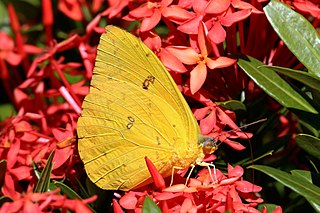
Phoebis sennae, the cloudless sulphur, is a mid-sized butterfly in the family Pieridae found in the Americas. There are several similar species such as the clouded sulphur, the yellow angled-sulphur, which has angled wings, the statira sulphur, and other sulphurs, which are much smaller. The species name comes from the genus Senna to which many of the larval host plants belong.
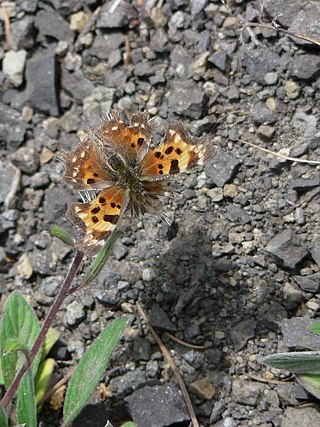
Polygonia oreas, the oreas comma, is a butterfly of the family Nymphalidae. It is found in North America in the mountains from southern British Columbia and southwestern Alberta to northern California.

The Euphyes is genus of North American butterfly of the family Hesperiidae (skippers), subfamily Hesperiinae.

The western tailed-blue is a Nearctic non-migratory butterfly that commonly takes flight during the spring and summer seasons of March–July. They can be best classified as having a presence of a tail on their hindwing, an upper surface that's bluish while the under surface is chalky-white with occasional black spots, and an orange spot toward the base of their tail. Their wingspan ranges from 0.875 to 1.125 inches. Larvae feed on various plant species including Astragalus, Lathyrus, Oxytropis, and Vicia. Adults feed on various things such as flower nectar, horse and coyote manure, urine, and mud.

Amblyscirtes vialis is a butterfly of the family Hesperiidae. It is found from British Columbia east across southern Canada to Maine and Nova Scotia, south to central California, northern New Mexico, Texas, the Gulf states and northern Florida.

Wallengrenia egeremet, the northern broken dash , is a butterfly of the family Hesperiidae. It is found in North America from southern Maine and southern Ontario, west across the Great Lakes states to southeastern North Dakota, south to central Florida, the Gulf Coast and south-eastern Texas.

Wallengrenia otho, the southern broken dash or broken dash skipper, is a butterfly of the family Hesperiidae. It was originally described by Smith in 1797. It is found from eastern Texas and the southeastern United States, south through the West Indies and Central America to Argentina. Strays can be found as far north as central Missouri, northern Kentucky and Delaware.
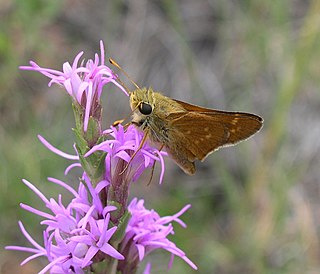
Hesperia leonardus, the Leonard's skipper, is a butterfly of the family Hesperiidae. There are three subspecies. Next to the nominate species, these are the Pawnee skipper, which is found in North America from western Montana and south-eastern Saskatchewan east to Minnesota, south to central Colorado and Kansas. Leonard's skipper ranges from Nova Scotia and Maine west through southern Ontario and the Great Lakes region to Minnesota, south to North Carolina, Louisiana and Missouri and the Pawnee montane skipper is endemic to the South Platte River drainage of Colorado.
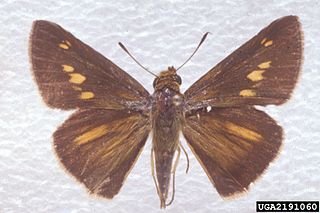
Euphyes dion, the Dion skipper or Alabama skipper, is a species of butterfly of the family Hesperiidae. It is found in scattered populations along the Atlantic coast of North America, from western Massachusetts and south-eastern New York south to north-eastern Florida, west to north-eastern Texas, and north to south-eastern North Dakota, northern Wisconsin, southern Ontario and southern Quebec. It is listed as a species of special concern in the US state of Connecticut.

Hesperia uncas, the Uncas skipper or white-vein skipper, is a butterfly of the family Hesperiidae. It is found from US Midwest to southern portions of the three Canadian Prairie provinces, north as far as Edmonton, Alberta.

Euphyes vestris, the dun skipper, sedge witch or dun sedge skipper, is a species of butterfly of the family Hesperiidae. It is found in North America from Nova Scotia west across southern Canada to southern Alberta, south to Florida, the Gulf Coast and eastern Texas. There are disjunct populations in the High Plains and Rocky Mountains and along the Pacific Coast.
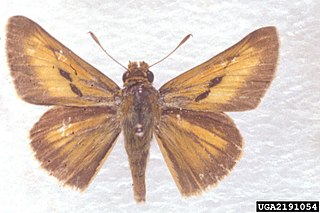
Euphyes bayensis, commonly known as the bay skipper, is a butterfly belonging to the Hesperiidae family. It is found in coastal Mississippi within the United States.

Euphyes dukesi, or Dukes' skipper, is a butterfly of the family Hesperiidae. It lives in the eastern United States and in a small portion of southern Ontario, Canada, in three distinct populations. Preferred habitats are shaded wetlands, with various species of sedge plants it uses as host plants for its larvae.
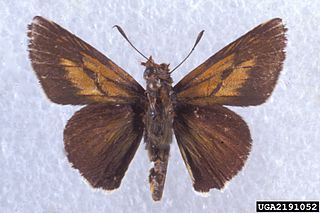
Euphyes arpa, the palmetto skipper, is a butterfly of the family Hesperiidae.

Euphyes bimacula, the two-spotted skipper, is a butterfly of the family Hesperiidae. It is found in North America, from northeast Colorado and western Nebraska; eastern Nebraska east to southern Quebec; southern Maine south to central Virginia; coastal plain south to Georgia; and the Gulf Coast.

Echinargus isola, or Reakirt's blue, is a butterfly of the family Lycaenidae. It is the sole representative of the monotypic genus Echinargus. It is found in Central America and the extreme southern U.S. Echinargus isola migrates regularly throughout most of the U.S. almost to the Canada–United States border, and very rarely into the southern prairies.

Hemiargus ceraunus, the Ceraunus blue, is a species of butterfly in the family Lycaenidae. The species was first described by Johan Christian Fabricius in 1793. It is found in the southwestern United States, southern Texas, Florida and the Florida Keys south through the West Indies, Mexico and Central America to South America. Strays may be found in North Carolina, Missouri, Kansas and Nevada. The habitat consists of open woodland, desert scrub, dunes, pastures, road edges and vacant lots.
Euphyes berryi, known as Berry's skipper, is a rare species of butterfly of the family Hesperiidae, historically found in wet areas from North Carolina to Florida.

Celastrina echo, known generally as the echo azure or western azure, is a species of blue in the butterfly family Lycaenidae. Celastrina echo have been observed in mostly western regions of the United States, including California, Oregon, Arizona, New Mexico, and Montana.



















